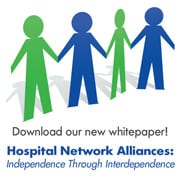 Community hospitals worried about losing local control through a merger or acquisition by a larger health system are exploring Network Alliances as a “best of both worlds” alternative. Through a formal working relationship with other hospitals and health systems, a community hospital can access needed resources while protecting its independence.
Community hospitals worried about losing local control through a merger or acquisition by a larger health system are exploring Network Alliances as a “best of both worlds” alternative. Through a formal working relationship with other hospitals and health systems, a community hospital can access needed resources while protecting its independence.
Noting traditional M&A activity remains brisk since the passage of the Affordable Care Act, the latest PYA white paper, Hospital Network Alliances: Independence Through Interdependence, says many community hospitals now are pursuing Network Alliances. These alliances can take many forms, but generally share these common characteristics:
- Shared resources and capabilities through clinical integration.
- Defined common interests.
- Stated financial commitment to support the alliance’s operation.
Based on its survey of existing Network Alliances, PYA identified five stages in the successful development of these organizations: (1) develop internal alliance strategy; (2) assess and engage potential partners; (3) jointly establish terms of relationship; (4) commence and maintain alliances; and (5) have an exit strategy. By not following these steps “the hospital runs the risk of rushing into a relationship without a foundation of trust,” according to the publication.
The PYA white paper concludes with 17 examples of Network Alliances that show the innovation, diversity, shape, and size of how these cutting-edge strategies can be tailored to meet specific needs and circumstances of all parties.
Put the deep and wide experience of PYA to work for you in developing and designing your Network Alliance by contacting the authors listed below.


